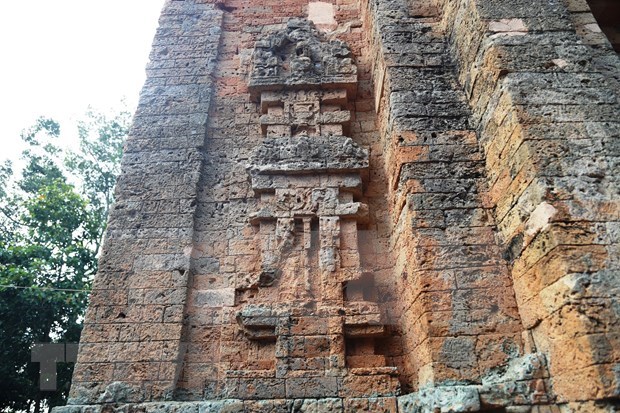Over-1,000-year-old tower embodies Oc Eo culture
Binh Thanh Hindu tower, built between the 8th and 9th centuries and belonging to the Oc Eo Culture, remains almost intact nowadays.
 Many reliefs on the tower are quite intact. (Photo: VNA)
Many reliefs on the tower are quite intact. (Photo: VNA)The tower is one of the few remaining ones from the culture existing in the Mekong Delta region. It got the name Binh Thanh from its location on the right bank of Vam Co Dong River in Binh Phu hamlet, Binh Thanh commune.
The Binh Thanh tower was discovered along with Chop Mat tower in Tay Ninh in the early 20th century via an archeological report by the Indochinese archaeological research library.
Located on a high and fairly flat land, the building is hidden under shady trees, creating an extremely poetic, wild, mysterious, pure and peaceful scene.
Belonging to the Oc Eo Culture, its formation was identified to be around the 8th – 9th centuries. Through ups and downs over a thousand years, the ancient tower’s special architectural features remain almost intact, forming an important part of the nation’s cultural heritage.
It is the only Oc Eo tower that has an almost intact stone wall since discovery. Quite similar to other Champa towers in the central region, its construction technique employed the use of baked brick materials that were stacked skillfully and tightly without using adhesives. However, it is a pity that such technique has so far been lost despite restoration efforts by many scientists and archaeologists over years.
 An overall view from behind the side of the Binh Thanh ancient tower. (Photo: VNA)
An overall view from behind the side of the Binh Thanh ancient tower. (Photo: VNA)Built on a square plot, the remaining one is 10 metres high. Each of its sides is 5 metres long. They face the four directions east, west, south and north.
At one metre wide and two metres high, the east-facing main door of the tower protrudes completely. Above it is a 2 m x 0.8 m rectangular stone, which was carved with extremely sophisticated stylised chrysanthemums.
The West, South and North main doors all have fake doors that are embossed with extremely delicate and elaborate patterns.
Decorative motifs are repeated in many parts of the tower and get smaller toward its top, creating angles and edges for the entire construction. Meanwhile, reliefs are embossed around the tower, making it a solid and elaborate work of architecture.
In 1993, the tower was recognised by the then Ministry of Culture and Information (now the Ministry of Culture, Sports and Tourism) as a cultural historical relic site in 1993.
Not only having historical and architectural values, the relic also embodies many special values about the cultural life, religion and belief of ancient people. Its ingenious construction and sculpture techniques reflect the peak development of the Oc Eo Culture.
The Oc Eo Culture was first discovered in 1944 via artifacts found in the sites of Ba The Mountain, now in Oc Eo town, Thoai Son district in An Giang province.
Scientific research has unravelled a brilliant culture with a system of dense monuments on a large scale with a variety of artifacts, diverse in types and high levels of technique, aesthetics, arts, and interactivity with major cultural centres at that time.
Artifacts of the Oc Eo Culture are valued as significant historical documents and evidence of a prosperous culture in the history of Vietnam./.













